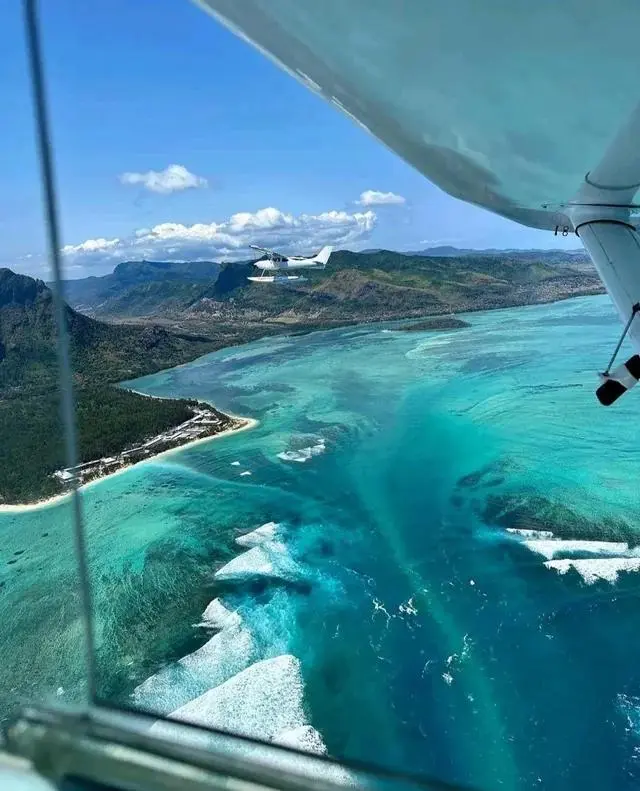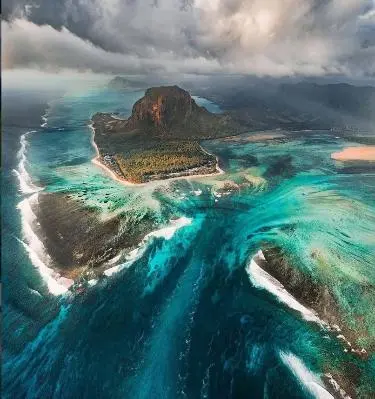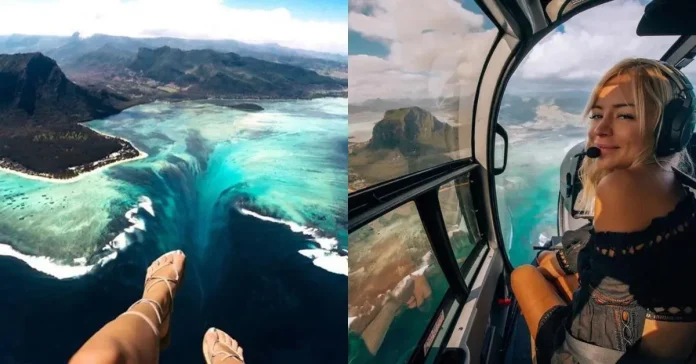The ocean is home to many astonishing wonders, from vibrant coral reefs to mysterious sea creatures. Yet, one of the most mesmerizing and little-known phenomena is the underwater waterfall, an illusion of cascading water deep within the ocean. This seemingly paradoxical natural feature evokes both awe and curiosity, a visual trick played by the complex interplay of currents, sediments, and varying water densities.
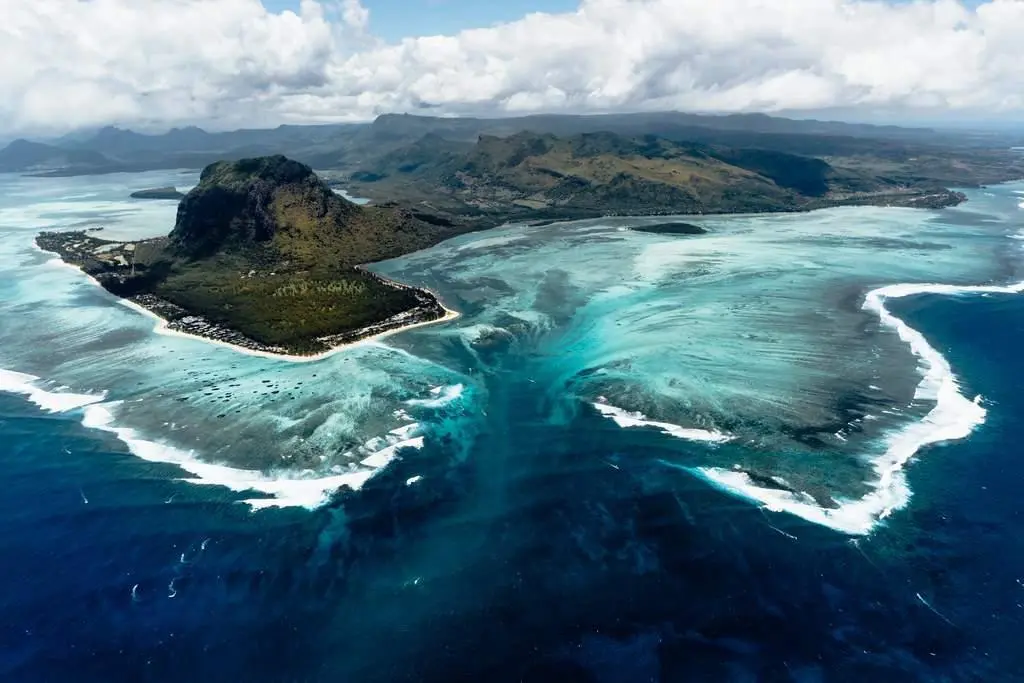
The only way you can have a look in Mauritius’ Underwater Waterfall.

The Magic Behind the Illusion.
At first glance, an underwater waterfall appears to be an actual waterfall, as if water is tumbling over the edge of an abyss deep in the ocean. But in reality, what we see is a trick of the eye. The “waterfall” effect is created by differences in water density—caused by variations in temperature, salinity, or currents. When heavier, colder, and saltier water flows downward beneath lighter, warmer, and fresher water, it creates a stream that looks like a waterfall. This layered movement mimics the familiar cascade of terrestrial waterfalls.
However, unlike their land-based counterparts, these underwater phenomena are much slower and occur on a scale that can span kilometers. They can be found near the edges of underwater plateaus or continental shelves, where ocean currents funnel sediment and water in a dramatic plunge.

Mauritius’ Underwater Waterfall: A Nature’s Illusion.
Perhaps the most famous example of an underwater waterfall can be found off the coast of Mauritius, a tropical island in the Indian Ocean. Here, near the Le Morne Brabant Peninsula, lies one of the most stunning visual illusions in the world. When seen from above, it looks as though a massive waterfall is tumbling into the deep ocean.
In reality, this is an optical illusion caused by the shifting sands and silt deposits on the ocean floor. As these sediments are pulled away from the edge of the continental shelf, they create the illusion of a plunging waterfall. The vibrant colors of the water—ranging from brilliant turquoise to deep blue—enhance the visual effect. Although it’s a phenomenon of sand and silt rather than water, the scene is so convincing that many who witness it from a bird’s-eye view are left in awe.
Denmark Strait: The Largest Underwater Waterfall.
While Mauritius offers one of the most visually captivating examples of an underwater waterfall, the largest and most powerful one is hidden beneath the surface of the Denmark Strait. This underwater waterfall, located between Greenland and Iceland, holds the title of the world’s largest, dwarfing even the mighty Angel Falls in Venezuela.
The Denmark Strait Cataract is formed as dense, cold water from the Arctic Ocean flows into the Atlantic Ocean. The cold, heavy water sinks beneath the lighter, warmer water, creating a vertical flow that plunges more than 3,500 meters (11,500 feet). The sheer volume of water that cascades down this underwater drop is mind-boggling—approximately 175 million cubic feet per second. It’s a colossal, silent force that drives some of the ocean’s most important circulation systems, influencing global climate patterns.

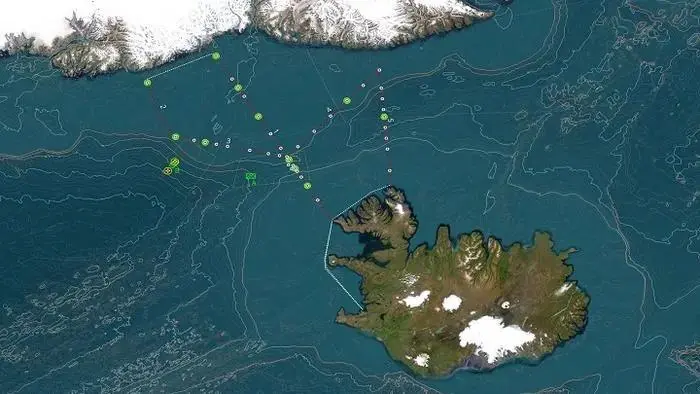
The Sognefjord Underwater Waterfall.
Another fascinating underwater waterfall can be found in the Sognefjord in Norway, the deepest fjord in the country. This waterfall is not as grand in size as the Denmark Strait Cataract, but it holds the unique feature of being located within a fjord. The Sognefjord underwater waterfall is created by the influx of dense, cold glacier water that meets the warmer seawater in the fjord. As the glacier water sinks, it creates a distinct underwater cascade that is hidden from the surface but is observable through deep-sea submersibles.
This underwater waterfall contributes to the unique ecosystem of the fjord, where nutrient-rich waters nourish a variety of marine life, from plankton to fish species that thrive in the cold depths.
The Ecological Significance of Underwater Waterfalls
While these phenomena are visually stunning, they are also important drivers of oceanic circulation and nutrient mixing. The downward flow of dense water in underwater waterfalls helps to move nutrients from the surface to the deeper parts of the ocean, supporting marine ecosystems. They are also a crucial part of the “thermohaline circulation” or the “global conveyor belt,” which regulates the Earth’s climate by distributing heat around the globe.
A Hidden Beauty of the Oceans
Underwater waterfalls, whether they are optical illusions like Mauritius’ sandfalls or real plunges of water like the Denmark Strait Cataract, remind us of the ocean’s mystery and complexity. They offer us a glimpse into the unseen dynamics that govern our planet’s marine environments. Often hidden from view, these underwater wonders challenge our perceptions and deepen our appreciation for the intricate workings of nature.
So, next time you gaze out over the ocean, remember that beneath the surface, hidden spectacles like underwater waterfalls are quietly shaping the world, fueling ocean currents, and sustaining life in ways we are only just beginning to understand.
